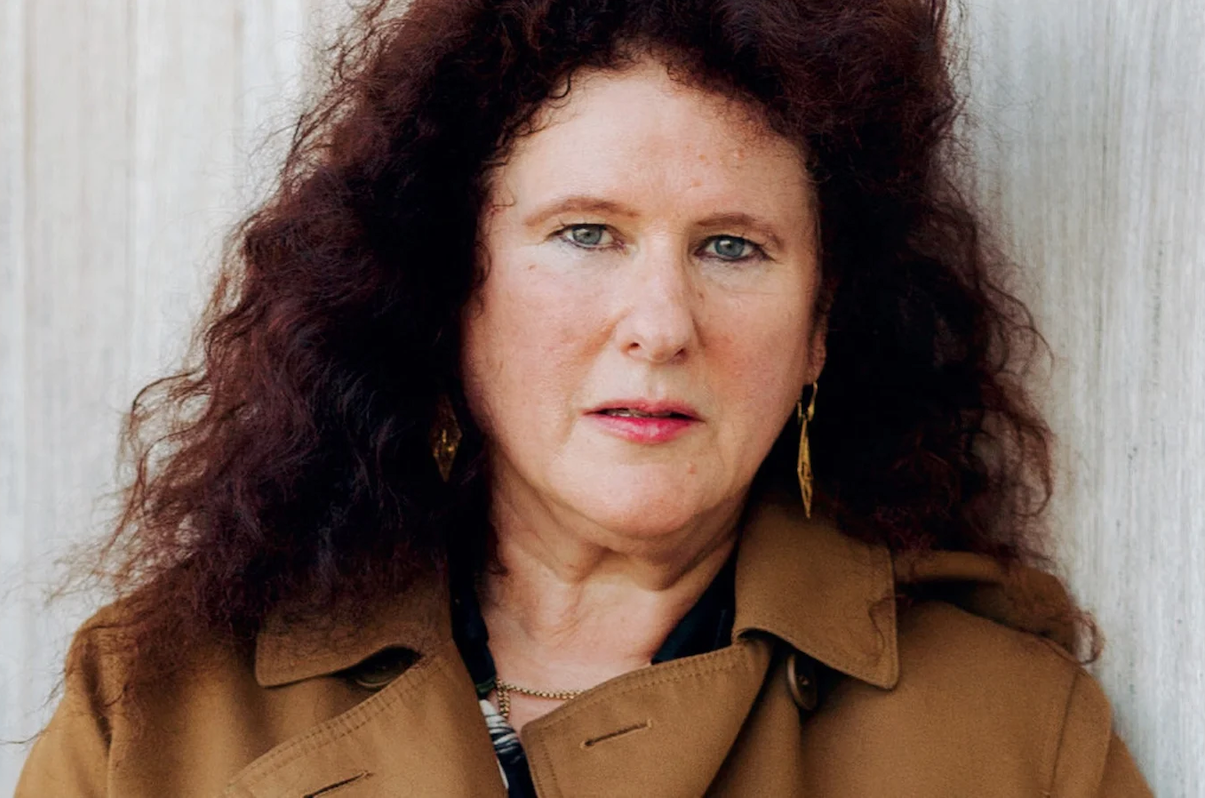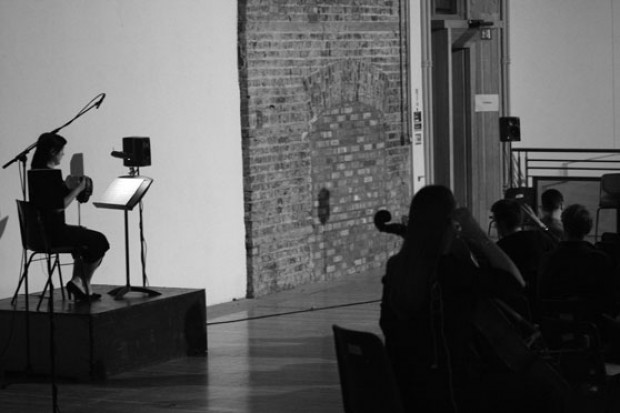
Singer and author Judith Mok
So That They are Not Lost
Judith Mok is a Jewish Dublin-based Dutch soprano who has long been embedded in the Irish music scene, having played with musicians such as Nick Roth and Cora Venus Lunny, and performed music by Elaine Agnew and stage work by Michael O’Loughlin. She is also a vocal coach who was worked with musicians as diverse as Dermot Kennedy, Loah and Thom Yorke. The State of Dark, her new memoir, is not her first reckoning with her Jewish inheritance: her first English-language novel Gael (2006) tells the story of a Jewish musician, and she has long had an interest in Sephardic music (she founded the short-lived Hamsa ensemble). But it is her most direct reckoning with her inheritance and with how closely the Holocaust touched her. We discover petrifying things, as Mok herself did. We see that her half-sister was hiding in their grandparents’ house when they, along with Mok’s aunt, were arrested by the Gestapo, and we see a hundred and sixty-three tally marks representing the members of Mok’s family who were murdered in concentration camps.
The State of Dark is called a memoir in the blurb, but that’s slightly misleading as a genre descriptor. First, it is not obviously about Mok at all: it’s about her family. Second, the light in which it casts its subjects is one of unequivocal and unstinting adoration. It is really a celebration rather than a memoir.
Mok’s generosity of spirit is unfaltering. Her love for her family is palpable throughout, as is her desire to give them a voice, record their story. Mok’s own life comes up only rarely. Mostly it is when it allows her to better celebrate her family. But in one of the few instances where she gives her antagonists the honour of writing about them, she recounts how pivotal her hero and mentor Elisabeth Schwarzkopf was for her in order to underscore the depth of the betrayal she felt when she learnt about Schwarzkopf’s Nazism. (It is clear that Mok does not buy the excuse Schwarzkopf gave concerning her membership of the Nazi Party – that it was a professional necessity – and still less does she forgive her.)
High society
It is not hard to see why Mok is proud of her family. She was born to Riemke Timmermans and Maurits Mok. Before the war, Riemke’s family were members of high society: they spent time with Mahler (Mok’s grandfather, a businessman, financed Dutch performances of Mahler’s work) and Riemke’s mother was known for her dazzling glamour. Riemke herself was proudly independent, and a lover of music and theatre. The family’s wealth and property was all confiscated by the Nazis after the invasion of the Netherlands. Riemke was initially hidden by friends of the conductor Willem Mengelberg, but she escaped when she heard them talk about joining the Dutch Nazi Party, spending the rest of the war under the aegis of various allies. After the war, she met and married Maurits.
Maurits came from a lower middle class background and left school at fourteen to work. Fortunately his first boss saw that he was destined for greater things, and paid for an education (in work hours) which Maurits went on to use to become a renowned poet who published dozens of works. He saw the war coming more clearly than most, but refused to flee the country. He hid for most of the war in the attic of some acquaintances who blackmailed him for drugs and, escaping that situation, saw out the war in a fellow writer’s place.
After the war, Maurits and Riemke, all their wealth gone and most of their family (including all their parents) dead, moved to an artists’ colony in Bergen where they had a modernist house designed and built for them as a gift from a Jewish benefactor. This extraordinary change of luck, like many of the absurdities of being a European Jew in the twentieth century, is mentioned without much comment. It is of a piece with the extremely affecting ‘flat’ or ‘rough’ style throughout the book. Another example of this is how Mok will baldly juxtapose the grace and lightness of her aunt Saar, say, with her ignominious fate: she saw her husband humiliated and murdered by Nazi soldiers, and was so traumatised that she no longer recognised her child, and never recovered.
Schwarzkopf
This disjointedness or refusal of style reaches its apogee in the section on Schwarzkopf, where Mok simply gives a list of what Schwarzkopf and Mok’s family where doing in this or that year:
1939: Schwarzkopf becomes acquainted with Joseph Goebbels, Hitler’s right hand, Reich Minister of Propaganda. A man with a great sense of culture. He appreciates her art as much as her blonde qualities.
1939: My mother plans her departure for the USA. Will she ever again see the field of tulips, the multicoloured blankets that cover her native land? (p. 114)
This sort of list would normally be worked into a narrative in a later draft of a text. To leave it as bare notes leaves the reader wondering how these things can co-exist, how we can simultaneously entertain such disparate thoughts. Similarly, one wants to know how Mok’s mother and grandmother, when they were young and elegant women, psychologically dealt with being the incarnation of privilege while also knowing, as Jews, that that privilege is only ever given on licence and can be stripped away without warning. (Mok alludes to this in the briefest way on p. 40: who was her grandmother’s glamour supposed to dazzle?) Mok offers no attempt to make sense of such things, and this seems to be her way of saying that there is no making sense of them. She gives us the bitter herb, the maror, of her tale as something that cannot be sweetened.
For future generations
Mok talks about why she is telling her family’s stories. It is so that they are not lost. More specifically, she is writing them down before forgetfulness renders them lost forever, and telling them specifically for future generations of Jews: a framing chapter takes the form of a letter to her daughter. She also wants to bear witness to the enormity of the Nazis’ crimes and make liars of those who wanted ‘[t]he scratchmarks of nails on the filthy wall of a Nazi gas chamber… to be [Jews’] legacy’ (p. 18). But she is also recounting her own story: she pictures her relatives as mirror shards which collectively show Mok’s own reflection (p. 8); she is telling ‘their story, not mine, until I see myself – and feel that others are seeing me – through their story, and until in fact their story is me’ (p. 63). In telling her family’s stories, Mok is facing the ‘state of dark’ that was too horrible for her parents, many other first-generation Holocaust survivors, and until now Mok herself, to face, collecting the shards of their lives and composing them into a mirror that can, through the Jewish rite of tikkun olam, help repair the world.
How is The State of Dark supposed to be this help? How are we supposed to digest her maror? Mok’s answer is occasionally cryptic, in koanic images: ‘an existence so new that there was no room for a mere shadow’ (p. 7), ‘shards of forever shattered light’ (ibid.). But the uncomfortableness of these metaphors is the uncomfortableness of a grief that cannot be told: of there being nothing that can be said to ease a situation, no way to heal the wound. There is great courage in Mok, for her memoir to offer no hope other than what is embodied in the writing of it.
The State of Dark by Judith Mok is published by Lilliput Press. Visit www.lilliputpress.ie.
Subscribe to our newsletter.
Published on 4 January 2023
James Camien McGuiggan studied music in Maynooth University and has a PhD in the philosophy of art from the University of Southampton. He is currently an independent scholar.

















